Roof gutters
The rainwater that drains from the roof has tremendous destructive power. First, the walls and foundation of the house are constantly getting wet, and this is fraught with the fact that they may very soon collapse. Secondly, this water falls from the height of the roof to the blind area, and after a while it washes out the grooves in it, which will also lead to its early destruction. Thirdly, the liquid flows from the roof and penetrates into the ground near the house, where there may be an underground garage or basement. This will cause these rooms to be flooded. It can take a long time to list the various consequences of uncontrolled rainwater, but it all comes down to the fact that rainfall, which can happen very often during a season, gradually destroys your home, shortening its operational life. To avoid this, you have to make or buy a drainage system, without which no house can do. It will collect all the water that drains from the roof and take it to the place of your choice. The main element of such a system are gutters for draining water from the roof, which take all the water, feeding it into the drain pipes. In this article we will take a detailed look at what elements the drainage system consists of, why it is so important, what material it is better to buy a system of and how to install it correctly.
Roof drainage system
You need to know that without a drainage system, your house can not function properly, it is an integral part of your home, which helps to preserve it for many years. Your walls and foundation will be intact, which will increase their service life and appearance. To summarize, this system performs three functions:
- Protective function.
- Rainwater harvesting function.
- Complements your home, performing a decorative function.
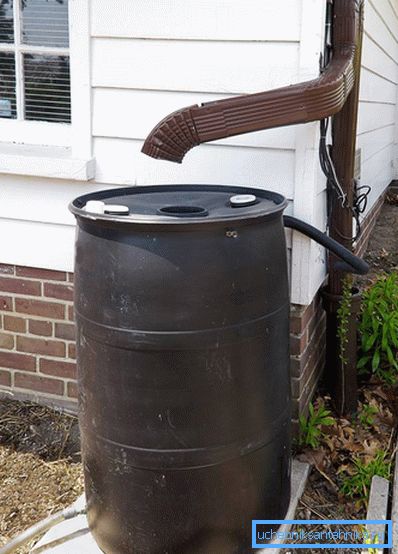
With protective and decorative features, everything is clear. But what about water harvesting? This is very useful as a savings, especially if you are a landlord who has his own garden or vegetable garden. By collecting rainwater in a barrel or tank, you can provide your plants with constant watering, even if the water is turned off. You will not spend extra money to pay for water bills. Moreover, rainwater is very useful for plants. Therefore, by organizing such a system, you will kill several birds with one stone.
Advice that drainage systems can be divided into two types:
- Internal system
- External system
The first type is always settling down on a flat roof. In this case, the roofing material is laid with a certain slope leading to the funnel, which receives rainwater and feeds it further into the drainpipe. This pipe is placed inside the premises or in special technical cavities.
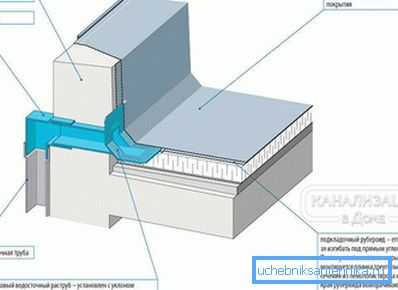
In our article, we will consider the external drainage system, as it is suitable for conventional pitched roofs, which are the most widespread. It is installed on the roof overhangs and collects all the water from the roof.
What items are included

The drainage system consists of a whole set of elements that, interacting with each other, perform the intended functions. This set of elements includes:
- gutter, one of the main elements, which is designed to collect the draining water from the roof. It can be made from various materials, different shapes and sizes;
- plugs for the gutters, which are needed at the end of the gutter, where the funnel is not provided. They do not allow the water accumulated in the gutter to flow to the blind area;
- connections for gutters that combine pieces of products together. Since the gutters are not made longer than 2.5 m, they have to be connected. After all, if the wall of your house has a considerable length, you cannot do without one element. The connectors have a rubber seal that ensures the tightness of the connection. Therefore, the water passing through it will not leak;
- funnel - an element that connects the gutter with a drain pipe. It is through the funnel that water from the gutter enters the vertical drainpipe;
- drainpipe, which is mounted under the funnel. Water is directed through it to the place you have chosen;
- corner of the gutter, so that you can bypass the corners of the building, while maintaining good hydrodynamics;
- brackets, fixing elements, through which the gutters are fixed in place, near the overhang of the roof. They are similar to the hooks in which the gutter will be placed. Depending on the situation, they may be of different designs;
- fixing clamps for sewers. They are attached to the wall from top to bottom and serve to fix the pipe so that it does not fall off during strong winds or as a result of mechanical effects;
- knee pipes and drain knee (outsole), which serve to drain fluid from the blind area and the building's base. The drain knee is mounted at the bottom of the pipe so that the water flows to the place you need, whether it is a tank or storm sewer. Knee pipes are used to change the direction of the drain pipe.
These are the main elements of such a system. But additionally, a special protective grid, or leaf trap, is installed in the gutters, which protects it from debris, leaves, etc. Thanks to this drain does not clog and clearly performs its functions.

Tip! For decorative purposes, instead of drainpipes, you can use special chains. On them water will flow into a container or a flower bed, for example, which stands under the funnel. It not only diverts water, but also complements your home, making it more attractive and interesting. And if you still find beautiful gutters that will be combined with a chain, you can surprise all your visitors.
All these are components, without which the system can not function properly. The basis for it are gutters that collect water. Let's consider what they are and what is important to know when installing them.
Sizes of gutters and drain pipes
The most important elements of the entire system can surely be called gutters and pipes, which is important, they will not fulfill their purpose qualitatively without the other, as the water must not fall from the gutters, but be directed to drain to the allotted place. Such products can be bought on the market, they are sold as a complete set, with all fasteners and connections, etc., or separately. Here you have to decide what and how to take. If you purchase a complete set - it will be much easier, you will only have to install it according to the instructions, assembling everything as a designer. When buying everything separately or only some components, you will have to make brackets or other component parts yourself. It will be cheaper, but it will take time and skill from you. The main thing you need to do is choose the right size of the gutter and pipe, which are different.
Most often, the diameter of the gutters is in the range from 90 mm to 150 mm, and the diameter of the drain pipes is from 75 mm to 120 mm. Their choice depends on the area of your roof. Everything is simple and logical: the larger the roof - the more diameter is needed to hold the entire flow of water, and vice versa. To be precise, then:
- For small roofs, the slope of which ranges from 10 to 70 m2, Experts recommend buying gutters with a diameter of 90 mm, and pipes with a diameter of 75 mm to them.
- For medium roofs, the slope area is from 100 to 200 m2, gutters should be used with a diameter of 100–130 mm, and pipes - 90 or 100 mm.
- For large roofs, with a slope of over 200 m2, gutters with a diameter of 150 mm are ideal, and pipes with a diameter of 120 mm are suitable for them
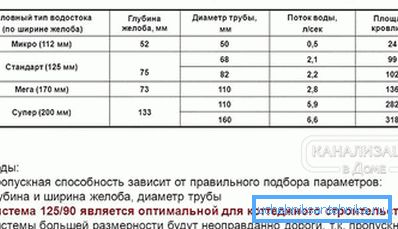
All this is not just so, because if you choose the wrong product, a large flow of water can accumulate in them, and everything will pour out over the top, and this is already bad.
In addition to the fact that the gutters have different sizes, they may differ in the material from which they are made and even in their shape.
What material to choose

It should be noted that finished products must meet certain requirements, the main of which are:
- High strength to resist various external factors. Since they will be outside, they will be affected by wind, hail, ice from the roof, or someone may accidentally catch a pipe. Therefore, it is important that the gutters and pipes withstand these impacts well, and you do not have to change them often.
- Durability and resistance to temperature extremes. Constant sunshine, rain and other precipitation, the external environment - all this can spoil the material, causing its corrosion or deformation. To avoid this, choose quality material.
- A good appearance is, of course, not the main thing, but the first thing that people pay attention to. Everyone wants their home to be beautiful, so the elements must be appropriate.
Choosing products, pay attention to these indicators, if you want the drainage system to serve you for a long time. The entire drainage system, as well as the gutter itself, can be made of two types of material:
- Metal.
- Plastic.
These are the main materials that have passed the test of time and distinguished themselves by their positive qualities. Metal products can be divided into several types:
- from galvanized steel;
- from aluminum;
- from copper;
- from zinc titanium.
To find out which material is better suited for gutters and the entire system, let's take a closer look at what the pros and cons of this or that material are, to find out how to choose the best option.
Galvanized Steel Chute

Galvanized steel gutters are very popular. Their predecessors were tin products, which were inferior in quality to galvanized. The material has its own advantages, such as strength and low price, due to which such gutters were used very often. However, galvanized steel quickly fails, becoming rusty under the influence of acid rain. Given this, the products have slightly improved: they began to be covered with polymers such as plastisol and pural. Due to this, the gutters became protected from corrosion, mechanical stress and fading, which significantly reduced the number of their weak points.
Now galvanized steel gutters are made in a wide range and colors, so you can choose such elements that would fit perfectly into the interior of your home. Such troughs are interconnected by special connecting elements with sealing rubber, brackets and locks. To fix the elements in place, brackets with snap-in construction are used, without the use of self-tapping screws, etc.
Material advantages:
- corrosion resistance;
- low price;
- strength;
- ease of installation;
- good appearance;
- a wide range of material and components.
Disadvantages:
- the fragility of the coating, if it is damaged during transportation or installation, then rust forms at this place;
- short term operation.
Aluminum gutters

Aluminum gutters are more practical because they are varnished or painted in different colors, which allows the material to last longer. Moreover, aluminum is much lighter, and the thickness of the gutter can be 0.8–1 mm. Gutters can be purchased already in finished form. They cost a little more than galvanized steel. Their connection is due to rivets and glue for aluminum. And to seal the connection and make it airtight, use a special paste or silicone. In addition, such gutters you can do yourself from sheets of aluminum. To do this, cut the canvas and bend it in size.
Material advantages:
- small weight;
- ease of installation;
- resistance to corrosion and ultraviolet;
- strength;
- good appearance;
- durability over 80 years.
Disadvantages:
- high price;
- electrochemical corrosion that occurs when aluminum comes into contact with another metal.
Copper gutters
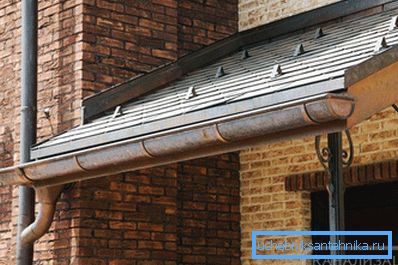
Copper gutters have the longest service life. A feature of such gutters is that in the manufacture they do not need additional processing by special means. Their connection is due to soldering or folding, without connecting elements. Over time, copper will oxidize, with the result that it will acquire a greenish tint, and in the future the surface will become almost malachite. All thanks to the patina - a coating on copper, resulting from oxidation. If your roof is made of rebate or copper, then this complements the overall look of the house and gives it a certain sophistication, as it will be in harmony with the elements of the drain.
Tip! It is important to note that as in the case of aluminum, contact of copper with other metals is unacceptable. Therefore, if your roof is made of metal, water flowing down will lead to corrosion of copper.
Pros:
- strength;
- resistance to external factors;
- durability;
- good appearance.
Disadvantages:
- high price;
- installation complexity;
- electrochemical corrosion.
Titanium Zinc Gutters
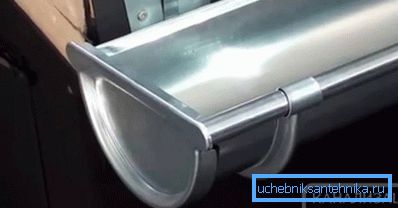
The material can be made in natural silver color, as well as later on with a special patina to improve the appearance. Its name does not mean that the main component of the material is titanium. In the composition of titanium-zinc, 99.5% of the total mass is zinc, and the rest is small additives of aluminum, copper and, of course, titanium. But despite the minimum proportion of titanium in the composition, it makes the product durable enough, because, as you know, zinc itself is quite fragile. The connection of the gutters occurs due to soldering, in which a special paste is used. This type of product can be called the most expensive, so it is used very rarely. But still a drainage system made of titanium-zinc will serve not only you, but also your grandchildren, since the operational life of the material is 150 years.
Pros:
- strength;
- durability;
- resistance to external factors;
Disadvantages:
- high price;
- complexity of installation.
Plastic gutter

This is the most common and popular material. Plastic gutters can be of a different color, which is uniform over the entire surface, since the dye is added at the manufacturing stage. This is good because even when products are scratched or damaged, it will not affect the overall picture, because nothing will be visible. Plastic - material is not subject to corrosion, so it will not rust. And in order to give the material resistance to chemical aggression and ultraviolet rays, it is coated with titanium dioxide or acrylic. Such gutters do not require additional care and treatment.
The gutters are connected to each other by connecting couplings with rubber seals, snaps and glue joints. Plastic products are inexpensive, lightweight and will serve you for a long time, for 50 years. Moreover, the material is able to withstand significant temperature differences, from –30 30 C to +60 C C, loads from snow and wind. Notice that even damaged gutters can last for quite a long time, while the same pural, if you just scratch it, will soon have to be replaced and thrown away.
Pros:
- least cost;
- possess a smooth surface thanks to what dirt inside does not accumulate;
- corrosion resistance, it just never appears on plastic;
- ease of installation;
- linear expansion is 7 times better than metal products.
Disadvantages:
- low resistance to negative temperatures, when the temperature drops below 30? C, the plastic becomes brittle;
- under mechanical action, the material will crack and break, and the metal will simply collapse.
This is all you need to know to decide which material to choose when buying gutters. Weigh the pros and cons, analyze your climate, living conditions, and the amount of funds. This will help you choose the right option.
Form of finished products
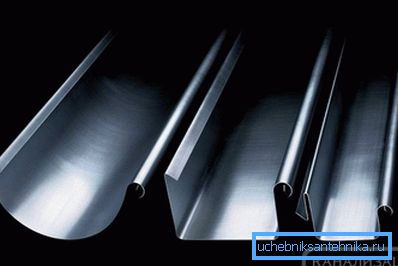
Besides the fact that the gutters are sold in various sizes and from different materials, they also have a variety of shapes. Such structures depending on the cross-section are:
- semicircular;
- trapezoidal;
- semi-elliptic;
- rectangular;
- square.
The most common and as we know them are the semicircular gutters. They can be used for various roof designs. The edges of the grooves, wrapped in or out, serve as stiffening ribs to increase the stability of the entire groove to all loads. Elements that have a semi-elliptical shape can hold a large amount of water in themselves, and therefore they are bought in the case when the slope of the roof is large.
The use of square and rectangular gutters is not so common due to the fact that they are selected exclusively for the design of the whole house. Moreover, such a construction can easily be damaged by snow coming down from the roof, therefore their installation takes place in a special way, and snow catchers are necessarily mounted on the roof.
Tip! The easiest way to care for semicircular and semi-elliptical forms, as they do not have such hard-to-reach places, like corners, where dirt can accumulate.
What form of gutters to choose is a purely personal matter. But you need to know that the pipes for such parts are selected appropriate. For example, for semi-circular and semi-elliptic products, round drain pipes are needed, and for boxed (trapezoid, square or rectangular) square pipes.
Main selection criteria

Based on all of the above, you need to make a decision on which system to use for draining water. Your choice should be based on how much rain falls in your area in the winter time. If in winter the air temperature can reach –25? C and below, and you know that there is a risk of ice and ice formation, it would be more rational to install a metal structure.
Tip! Regardless of whether you are using metal or plastic, experts recommend using steel fasteners (brackets and pipe holders).
The second factor that you should consider is the shape of the gutter. After all, from what will be the geometry of the structure, depends on its effectiveness in collecting water. The most practical and convenient in operation are semicircular and semi-elliptical forms, which are in great demand, they are easy to clean, and they are able to hold a large amount of water.
The last factor is size. You need to measure and find out what area the slope of the roof of your house has in order to accurately choose the size of the gutter section. Then the whole system will function correctly and without failures. Well, the color of the parts is important, which you should choose based on the interior of the house. Drainage must be in harmony with the architecture of the entire building.
Tip! When you want to carry out all the installation work on your own, pay attention to designs that are easy to assemble. After all, for example, copper elements need to be soldered, which not everyone can. It is much easier to connect parts with a simple element.
You just have to buy the necessary items. But this is not the end, since you still need to install a watercourse system. How to do it right, we will look further.
Rules for the installation of gutters and drainage system

In order for your installation to be carried out correctly, it is important to read the instructions and recommendations in the manual indicated by the manufacturer of the products you purchased. Basically, during installation, you must adhere to the following rules:
- Installation of brackets under the gutter should occur at a specified distance from each other. For metal gutters, the installation step is 80–120 cm, and for plastic products - 50–80 cm.
- Gutters are mounted under the overhang under a slight bias, about 3? (at 1 m length slope of 3-5 mm) to the place of flow. This will be enough so that the water flowing down from the roof does not stagnate in the gutter, but flows freely to the funnel, and it does not overflow with heavy rain.
- The location of the edge of the gutter relative to the plane of the roof should occur with an indent of at least 3 cm. That is, from the edge of the roof it is necessary to mount a goof at a distance of 3 or more cm. Then the snow will not damage it and will not tear it from the roof.
- In order for water to always fall clearly into the container, its outer edge must be set to one third of the diameter of the gutter, so that a large part, that is, 2/3 of the width, protrudes beyond the edge of the roof.
- If the roof is too steep, it is not always possible to align the system with the 3 and 4 points. In this case, on the roof you will need to install special barriers or snow catchers that will protect the gutter from the snow.
- It is better to position the inner edge a little higher than the outer edge so that in case of a blockage the water accumulating in the chute does not fall directly on the walls and facade.
- When installing the gutters, it is important to maintain thermal gaps at the junction of the elements. Since the structure will be constantly affected by sunlight, and then they will cool again, the connections should allow the elements to move freely. Therefore, it is not necessary to clamp the parts of the structure at the attachment points.
Considering all these tips, as well as instructions for your design, let's begin the process of installing all the elements.
How to install a drainage system
Have you collected a designer for a long time? Now you can do something like this. Installation of the system is simple, but unsafe, since all the work is done at height. To protect yourself from an accident, use a working, reliable stepladder or scaffolding.

First, you need to calculate how many meters your walls are in length, where the gutters will be fixed. It is also advisable to estimate the project or scheme, how and where the gutters will be placed, how many drain pipes there will be, etc. Immediately you can calculate how many components are needed. At 10 m gutter need 1 funnel. Calculate how many funnels are required, exactly the same number of pipes needed. The number of brackets depends on the total length of the gutters, as well as at what distance from each other they are mounted. Clamps for vertical pipes are easier to calculate, as 2–3 clamps will be used for 1 pipe. All this is best done in advance to quickly complete the installation.
Now it remains to install the system in place. All work is divided into several stages:
- Outlined space for installation brackets. To give them a bias, put the starting and ending points, given the bias, and connect them. On the formed line put the following points, taking into account the pitch mounts. Now it remains only to establish them in their places.
- Now you need to assemble the chute. It is more expedient to do this on earth. Then you not only protect yourself, but also qualitatively collect them. Connect the parts with each other by means of a fastener, which is provided, and in the right places install a funnel.
- Install the finished structure on the gutters, and fix them with fasteners provided by your equipment.
- After the gutters are securely fixed, it is necessary to connect the funnel with the knee, if necessary, and install the drain pipe. Advice that this pipe should not fit closely to the wall. It is necessary to maintain a distance of 3 cm and more. To install it vertically evenly, use a plumb line. In the right places, put the fixing clamps and install the pipe in place.
- From the bottom of the pipe attach guide elbow, which will drain the water from the foundation.
- In those places where the end of the gutter is not involved, you need to put the plugs so that the water does not overflow.
- If the system needs to be positioned around the perimeter, connect an angle chute to the chute, which can bypass the corner and continue installation in the same way.
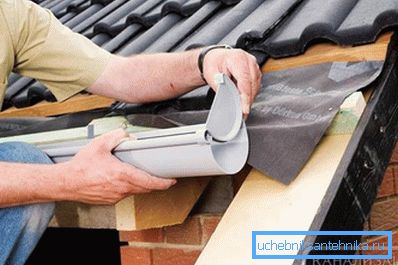
This is how you can easily and easily install a roof drainage system. It will be properly selected and installed according to all the rules, so a long service life and high-quality water drainage is provided to you. It is only necessary to choose all the components correctly: material, size, shape and color, and also to assemble everything correctly. But now your house is protected from water, which would gradually erode it and destroy the foundation.
Tip! Water can be diverted to a closed system for collecting and draining water, for example, a drainage system in the ground, storm sewers, simple sewers, a tank for collecting water, etc.
If you managed to make such a system yourself, share your experience with other users. This will help everyone to make sure that doing all the work with their own hands is possible. It will save your money and give you confidence that you are the real owner in the house.
See also:
- How to install a heating cable for drainage.